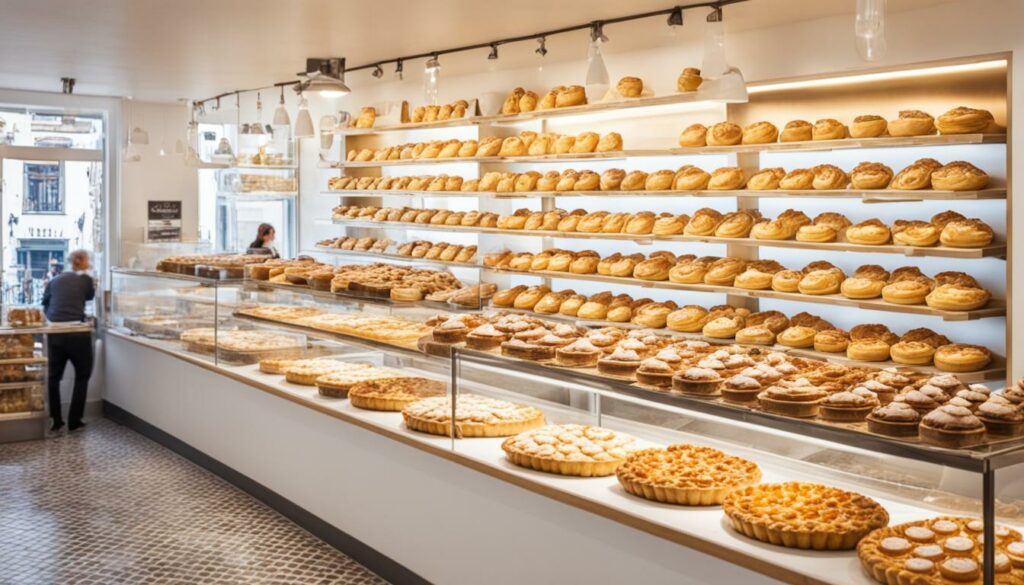
A friendly “Pastéis de Nata Throw-down” contest is taking place in Fall River and New Bedford, two sister cities known for their Portuguese culture and food. The contest aims to determine which city makes the better egg tart. Nine bakeries are competing for “The Golden Nata” trophy, and voters can also write in their favorite South Coast spot. Pastel de nata is a traditional Portuguese custard tart with a flaky pastry crust and a bright yellow caramelized custard filling. The contest organizers hope to increase tourism and support local restaurants while celebrating the culinary traditions of Portugal.
Key Takeaways:
- Pastel de nata and pastel de belem are popular Portuguese custard tarts.
- The friendly “Pastéis de Nata Throw-down” contest aims to determine which city makes the better egg tart.
- Nine bakeries are competing for “The Golden Nata” trophy in Fall River and New Bedford.
- Both pastel de nata and pastel de belem have a flaky pastry crust and a sweet custard filling.
- The contest organizers hope to promote tourism and support local restaurants while celebrating Portuguese culinary traditions.
What’s the Difference Between Pastel de Nata and Pastel de Belem?
The terms pastel de nata and pastel de belem are often used interchangeably, but there are some slight differences between the two. Pastel de nata refers to the general Portuguese custard tart, while pastel de belem specifically refers to the custard tarts made at the famous Pastéis de Belém bakery in Lisbon.
The tarts at Pastéis de Belém are made using an ancient recipe from the Jerónimos Monastery. The filling of pastel de belem is slightly richer and creamier compared to the lighter and simpler pastel de nata. Both tarts have a flaky pastry crust and a sweet custard filling, making them beloved traditional Portuguese desserts.
To summarize:
| Pastel de Nata | Pastel de Belem |
|---|---|
| General Portuguese custard tart | Custard tarts from Pastéis de Belém |
| Lighter and simpler filling | Richer and creamier filling |
“The terms pastel de nata and pastel de belem are often used interchangeably, but there are some slight differences between the two.”
The Origins and Popularity of Portuguese Custard Tarts
Portuguese custard tarts have a long and fascinating history, with their origins dating back to the medieval period in England. Interestingly, the earliest known recipe for a custard tart can be found in the cookbook “Forme of Cury” from 1390. However, it was in Portugal that these delectable treats truly flourished and became an integral part of the country’s culinary traditions.
Today, Portuguese custard tarts are revered and celebrated worldwide. They have become an iconic symbol of Portuguese cuisine and are a staple in Portuguese bakeries, with each region offering its own unique twist on this beloved treat. But perhaps the most famous and sought-after custard tarts are the ones made by the legendary Pastéis de Belém, a renowned Portuguese bakery located in Lisbon.

“The secret to our famous Pastéis de Belém lies in the ancient recipe that has been carefully preserved and passed down through generations since 1837,” says Manuel, the head pastry chef at Pastéis de Belém. “Our custard tarts are made with love and a deep respect for our culinary heritage.”
The popularity of Portuguese custard tarts has transcended borders, and these pastries can now be found in bakeries and cafes across the globe. The creamy custard filling and flaky pastry crust of these tarts have won over the hearts and taste buds of people from all walks of life, making them a beloved dessert among locals and tourists alike.
The Cultural Significance
The rise in popularity of Portuguese custard tarts can be attributed not only to their exquisite taste but also to the cultural significance they hold. These tarts represent the rich culinary traditions of Portugal and embody the warmth and hospitality of its people. They are often enjoyed with a cup of coffee or tea, adding a touch of sweetness to everyday life.
A Mouthwatering Legacy
As Portuguese custard tarts continue to captivate the hearts (and taste buds) of food enthusiasts around the world, their legacy only grows stronger. With their flaky crusts, creamy fillings, and a touch of caramelization on top, these pastries have become one of the most famous and beloved Portuguese delicacies. Whether enjoyed in Lisbon’s historic bakeries or savored from a local Portuguese bakery in your neighborhood, Portuguese custard tarts are a true testament to the rich culinary heritage of Portugal.
How to Make Brazilian Pastel de Belém
Discover the delightful flavors of traditional Brazilian desserts with this mouthwatering recipe for Brazilian Pastel de Belém. This Brazilian pastry is a variation of the classic Portuguese custard tart, resulting in a sweet and creamy treat that will transport you to the vibrant streets of Brazil. Follow these simple steps to create your own batch of Brazilian Pastel de Belém:
- Start by preparing the flaky and buttery pastry crust. In a mixing bowl, combine all-purpose flour, butter, water, and salt. Mix until the dough comes together and forms a smooth ball. Wrap the dough in plastic wrap and refrigerate for at least 30 minutes to allow it to rest and firm up.
- While the dough is chilling, it’s time to make the luscious custard filling. In a saucepan, heat whole milk over medium heat until it starts to simmer. In a separate bowl, whisk together sugar, egg yolks, and cornstarch until well combined. Gradually pour the hot milk into the egg mixture, whisking constantly to prevent curdling.
- Return the custard mixture to the saucepan and cook over medium heat, stirring constantly, until it thickens to a silky consistency. Remove from heat and let it cool.
- Preheat the oven to 400°F (200°C). Roll out the chilled pastry dough on a floured surface to about 1/8-inch thickness. Cut out small circles using a pastry cutter or a glass.
- Place the pastry circles into a greased muffin tin, pressing them gently against the bottom and sides to create a cup-like shape. Fill each pastry cup with the cooled custard filling, leaving a small border at the top.
- Carefully seal the pastries by folding the edges of the dough over the filling, creating a ruffled effect.
- Bake the Brazilian Pastel de Belém in the preheated oven for 20-25 minutes or until the pastry turns golden and the filling is set.
- Once baked, allow the pastries to cool slightly before removing them from the muffin tin. Serve warm or at room temperature, sprinkled with powdered sugar for an extra touch of sweetness.
Indulge in the delectable flavors of Brazilian Pastel de Belém, a traditional Brazilian dessert that perfectly combines a flaky pastry crust and a creamy custard filling. Whether enjoyed as a dessert or a snack, this Brazilian pastry will surely delight your taste buds and introduce you to the rich culinary heritage of Brazil.

Get Creative with Variations:
If you’re feeling adventurous, you can personalize your Brazilian Pastel de Belém by adding a twist to the traditional recipe. Here are a few variations you can try:
- Add a hint of citrus flavor by incorporating grated orange or lemon zest into the custard filling.
- Experiment with different spices like cinnamon or nutmeg to add warmth and depth to the pastry.
- For a tropical twist, substitute some of the whole milk with coconut milk to infuse the custard with a delicate coconut flavor.
- Top each pastry with a sprinkle of cinnamon sugar before baking for an extra layer of sweetness.
Explore your creativity and make Brazilian Pastel de Belém your own by customizing the recipe with your favorite flavors and ingredients.
Conclusion
The debate between pastel de nata and pastel de belem offers a tantalizing glimpse into the rich culinary traditions of Portugal and the deep-rooted love for these traditional Portuguese desserts. Both pastel de nata and pastel de belem share the same foundation of a flaky pastry crust and a delectable custard filling, but they also exhibit subtle differences that make each one unique.
While the pastel de nata is cherished for its lightness and simplicity, the pastel de belem stands out with its richer and creamier filling. The iconic tarts from Pastéis de Belém in Lisbon are renowned for their ancient recipe and continue to impress locals and tourists alike. In turn, the friendly “Pastéis de Nata Throw-down” contest in Fall River and New Bedford showcases the dedication of local bakeries and their commitment to preserving Portuguese culinary traditions.
Whether you find yourself indulging in the renowned pastel de belem from Pastéis de Belém or savoring the friendly competition between the two sister cities, both pastel de nata and pastel de belem provide an exquisite taste of Portugal’s culinary heritage. These traditional Portuguese desserts are a testament to the craftsmanship and passion of bakers who continue to create these delightful treats for generations to enjoy. Let the flavors transport you to the enchanting streets of Lisbon and immerse yourself in the rich culinary tapestry of Portugal.
FAQ
What is the difference between pastel de nata and pastel de belem?
Pastel de nata refers to the general Portuguese custard tart, while pastel de belem specifically refers to the custard tarts made at the famous Pastéis de Belém bakery in Lisbon. The filling of pastel de belem is slightly richer and creamier compared to the lighter and simpler pastel de nata. Both tarts have a flaky pastry crust and a sweet custard filling.
Where can I find Portuguese custard tarts?
Portuguese custard tarts can be found in Portuguese bakeries and cafes, particularly the iconic tarts from Pastéis de Belém in Lisbon. They have gained popularity worldwide and can be found in bakeries and cafes in various countries.
What is the history of Portuguese custard tarts?
Portuguese custard tarts have a long history, with their origins dating back to the medieval period in England. The earliest known recipe for a custard tart can be found in the cookbook “Forme of Cury” from 1390. In Portugal, custard tarts are particularly famous and have become a staple in Portuguese bakeries. The most iconic custard tarts are the ones from Pastéis de Belém, which has been making them since 1837 following their unique ancient recipe.
What is Brazilian Pastel de Belém?
Brazilian Pastel de Belém is a variation of the traditional Portuguese custard tart. It is made with a flaky and buttery pastry crust filled with a silky and creamy custard filling. It is a delicious representation of traditional Brazilian desserts.
Which is better, pastel de nata or pastel de belem?
Both pastel de nata and pastel de belem offer a delightful taste of Portugal’s culinary heritage. The choice between the two is a matter of personal preference. Some may prefer the lighter and simpler pastel de nata, while others may enjoy the richer and creamier filling of the pastel de belem from the famous Pastéis de Belém bakery in Lisbon.
